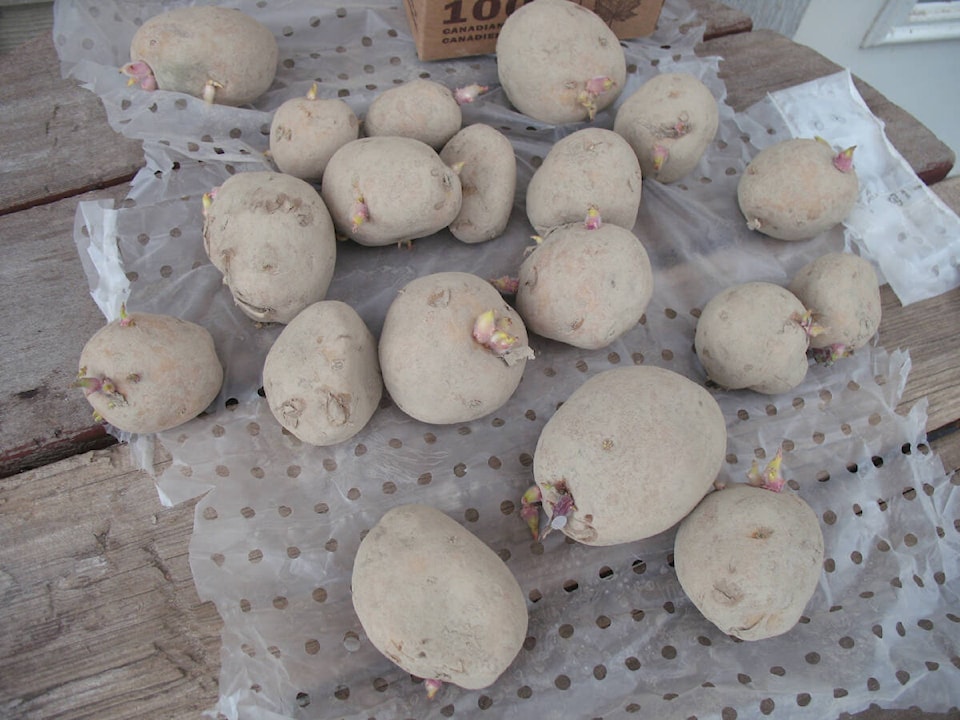By Mary Lowther
In his book Joy of Gardening author Dick Raymond recommends growing potatoes twice a year, five weeks before the last frost and again one week after the last frost. The first crop will be eaten as new potatoes and the second crop, destined to be harvested early October, will be stored for the winter. In 2019 the last frost was April 23, so I’ll plant my storage crop on the 30th.
All these years I’ve been misled by (or have misread) gardening books that said to dig trenches, lay potato pieces in the bottom and gradually cover them up with soil as they grow. It occurred to me recently that potatoes are tubers, not roots! I didn’t appreciate the difference until I looked it up: tubers are swellings on the stems. Therefore, if I want great potatoes I should feed the roots under my potatoes where the roots begin, rather than only relying on nutrients in the hilled soil to trickle down.
This year I added compost and fertilizer down a foot wide band in the centre of the potato bed over the winter cover crop, dug the whole works under and hoed it to break up lumps. Then I followed Steve Solomon’s suggestion in his book Growing Vegetables West of the Cascades by scooping out a potato-sized bit of soil for each potato piece, laying each piece in each hole and covering them up with more soil. I wish I had digested this information better when I first read the book, but sometimes I just have to learn the hard way.
I’ll hoe up soil, weeds and cover crop from the sides as the plants grow, gradually covering up the stems. I was mistaken about this as well because I thought this would produce more potatoes. Some authors say that more will develop above the main large ones, but others disagree. Some things they all agree on are that gradually covering the plants makes them sturdier and less likely to be damaged from frost, potatoes covered up won’t turn green and toxic and weeds are hoed down in the process. Solomon has a caveat regarding hilling though, warning us to “never cover the bases of the emerging vines with more than an inch or two with each hilling,” until they aren’t easily hilled anymore.
Fellow gardener Terry Williams used to build a box around his potatoes and gradually add peat moss instead of hilling. I convinced David that he wanted to build one too, but I didn’t find enough difference in the harvest to repeat the process. In retrospect, probably my harvest wasn’t up to scratch because I didn’t have decent soil below the tuber pieces I planted. Perhaps I should revisit the experiment.
As Solomon says, we don’t need to weed potatoes until after we’ve finished hilling them up, and we should just pull weeds out as we see them so as to not disturb the soil and damage tubers. I lay soaker hoses down the centre, usually in late May, and water every three days for half an hour. I also sprinkle compost tea on the leaves every two weeks and stop watering two weeks before harvest to develop tougher skins so potatoes will store longer.
I always buy new seed potatoes because I’ve read that potatoes bought for eating can harbour diseases that don’t show up until grown out. This year, though, I’m growing both kinds because I have the room and can afford to compare results.
If potatoes aren’t already chitted, I do it myself by leaving them flat in a bright place until sprouts grow out of the eyes. Then I leave small ones whole and cut the larger ones into pieces with at least two sprouts and plant each piece one foot apart down the centre of my three-foot-wide row.
A well-grown potato should contain 11 per cent protein and various minerals, but since 50 per cent of its nutrients lay just below the skin, I don’t peel my potatoes and have come to prefer them with their skin. Recent studies have shown that when skins are included, their glycemic index is much lower.
Please contact mary_lowther@yahoo.ca with questions and suggestions since I need all the help I can get.
